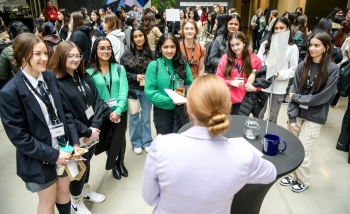Fostering the untapped curiosity of youth
I remember the feeling of the grass on the back of my neck as I lay gazing at the night sky. The Northern Lights were a common sight for those of us who lived on the English River First Nation reserve in northwest Saskatchewan, but the frequency of their appearance never diminished their beauty.
When I was around 10, my friends and I would lie on the newly sodded grass of the local school at night and watch the shapeshifting colours, exchanging theories about what they were. Were they spirits of departed loved ones that dance if you whistle, growing more colourful as they become happier, as our Dene elders told in their stories? Or were they something else? Something fantastical, like in the strange alien worlds Isaac Asimov described in the novels I found at the local library?
I didn’t know it at the time, but I was becoming a scientist. I was looking at the world, wondering how it all worked, coming up with hypotheses, and seeking evidence. Now, decades later, I am officially a scientist.
As I write this, I am sitting in the Perimeter Institute for Theoretical Physics in Waterloo, Ontario, where I am working on a particularly tricky computational problem involving string theory in higher dimensions. I’ll spare you the details.
Such advanced physics may seem a world away from my childhood fascination with the Northern Lights, but it’s fundamentally the same activity. I am examining how the universe seems to work, posing questions, and doing my best to find answers. And I’m driven by the same underlying motivation we are all born with: curiosity.
Asking questions is the most innately human thing we can do. For millennia, people have gathered around campfires, looked up at stars, and wondered why things are the way they are. I’ll be doing it this summer, and I bet you will too. Such curiosity drove my 10-year-old self to seek answers in books. The local library was a wonderland, a buffet of food for a hungry mind. The Encyclopedia Britannica fascinated me, especially the section on mathematics. I didn’t understand what all the strange symbols meant, but I was intrigued because they looked a bit like the written word in the Dënesųłiné (ᑌᓀᓱᒼᕄᓀ) language.
I spent practically an entire year in that library, until I was old enough to go to high school. I fed my curiosity with every kind of book, but was particularly drawn to ones that could explain what all those weird mathematical symbols meant. I still recall the rush of adrenaline when I solved my first mathematical problem. Using only my brain and some pencil-drawn symbols, I had demonstrated some inalienable truth about nature. That sense of satisfaction is what keeps me going as a scientist, even now that the problems have become significantly more difficult.
And that process – being curious, asking questions, seeking answers – is one I believe more young people should experience for themselves. There is so much untapped curiosity and talent among young people, particularly in remote areas like where I’m from, that just need opportunities to flourish. The world needs innovative young people more than ever. Humans have created big problems for our planet and ourselves, and I believe curious, creative, and courageous young people need to work together to find solutions.
That doesn’t mean I envision a generation of nothing but scientists. It means I hope young people will employ a scientific mindset and tenacity to whatever problems they tackle. I didn’t spend all my younger days with my nose in books. I made things with my hands. My cousin and I built a fanboat with a propeller made of wood we chopped and carved. Every activity required problem-solving, creative thinking, and an unwillingness to give up. I’ve never been afraid to fail, because failure is just another learning experience. I think more young people need to embrace that idea.
My path to science was not easy. String theory is difficult enough, but I have also struggled with bipolar disorder for much of my adult life. It has caused me some big setbacks, but perseverance in my quest to learn has kept me going forward.
My hope is that more young people – perhaps gazing up at the Northern Lights – will understand the joy of seeking answers, and apply their energy to seeking solutions for a better world.
Percy Paul was born and raised in Saskatchewan. He is a research assistant at the Perimeter Institute for Theoretical Physics. This piece was originally published in the Saskatoon Star-Phoenix, March 29, 2017.
About PI
Perimeter Institute is the world’s largest research hub devoted to theoretical physics. The independent Institute was founded in 1999 to foster breakthroughs in the fundamental understanding of our universe, from the smallest particles to the entire cosmos. Research at Perimeter is motivated by the understanding that fundamental science advances human knowledge and catalyzes innovation, and that today’s theoretical physics is tomorrow’s technology. Located in the Region of Waterloo, the not-for-profit Institute is a unique public-private endeavour, including the Governments of Ontario and Canada, that enables cutting-edge research, trains the next generation of scientific pioneers, and shares the power of physics through award-winning educational outreach and public engagement.


